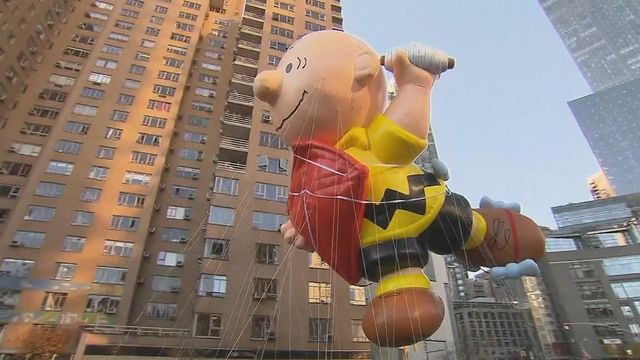Thanksgiving: Fact vs. fiction
Not to rain on our Thanksgiving Day parade, but the story of the first Thanksgiving, as most Americans have been taught it, is not exactly accurate.
Posted — UpdatedBlame school textbooks with details often so abridged, softened or out of context that they are rendered false; children’s books that distill the story to its most pleasant version; or animated Thanksgiving television specials like “The Mouse on the Mayflower,” which first aired in 1968, that not only misinformed a generation, but also enforced a slew of cringeworthy stereotypes.
High school textbooks are particularly bad about stating absolutes because these materials “teach history” by giving students facts to memorize even when the details may be unclear, said James W. Loewen, a sociologist and the author of “Lies My Teacher Told Me: Everything Your American History Textbook Got Wrong.”
“That mindset pervades everything they talk about and certainly Thanksgiving,” he said.
The Mayflower did bring the Pilgrims to North America from Plymouth, England, in 1620, and they disembarked at what is now Plymouth, Massachusetts, where they set up a colony. In 1621, they celebrated a successful harvest with a three-day gathering that was attended by members of the Wampanoag tribe. It’s from this that we derive Thanksgiving as we know it.
But it wasn’t until the 1830s that this event was called the first Thanksgiving by New Englanders who looked back and thought it resembled their version of the holiday, said KateSheehan, a spokeswoman for Plimouth Plantation, a living history museum in Plymouth.
The holiday wasn’t made official until 1863, when President Abraham Lincoln declared it as a kind of thank you for the Civil War victories in Vicksburg, Mississippi, and Gettysburg, Pennsylvania.
Beyond that, claiming it was the “first Thanksgiving” isn’t quite right either as both Native American and European societies had been holding festivals to celebrate successful harvests for centuries, Loewen said.
A prevalent opposing viewpoint is that the first Thanksgiving stemmed from the massacre of Pequot people in 1637, a culmination of the Pequot War. While it is true that a day of thanksgiving was noted in the Massachusetts Bay and the Plymouth colonies afterward, it is not accurate to say it was the basis for our modern Thanksgiving, Sheehan said.
And Plymouth, Loewen noted, was already a village with clear fields and a spring when the Pilgrims found it. “A lovely place to settle,” he said. “Why was it available? Because every single native person who had been living there was a corpse.” Plagues had wiped them out.
It’s been taught that the Pilgrims came because they were seeking religious freedom, but that’s not entirely true, Loewen said.
The Pilgrims had religious freedom in Holland, where they first arrived in the early 17th century. Like those who settled Jamestown, Virginia, in 1607, the Pilgrims came to North America to make money, Loewen said.
“They were also coming here in order to establish a religious theocracy, which they did,” he said. “That’s not exactly the same as coming here for religious freedom. It’s kind of coming here against religious freedom.”
Also, the Pilgrims never called themselves Pilgrims. They were separatists, Loewen said. The term Pilgrims didn’t surface until around 1880.
Possibly the most common misconception is that the Pilgrims extended an invitation to the Native Americans for helping them reap the harvest. The truth of how they all ended up feasting together is unknown.
“The English-written record does not mention an invitation, and Wampanoag oral tradition does not seem to reach back to this event,” Sheehan said. But there are reasons the Wampanoag leader could have been there, she said, adding: “His people had been planting on the other side of the brook from the colony. Another possibility is that after his harvest was gathered, he was making diplomatic calls.”
It is true that the celebration was an exceptional cross-cultural moment, with food, games and prayer.
The deadly conflicts that came after, though, created an undercurrent that is glossed over, Loewen said. Still, “we might as well take shards of fairness and idealism and so on whenever we find them in our past and recognize that and give credit to them,” he said.
Tisquantum, known as Squanto, did play a large role in helping the Pilgrims, as American children are taught. His people, the Patuxet, a band of the Wampanoag tribe, had lived on the site where the Pilgrims settled. When they arrived, he became a translator for them in diplomacy and trade with other native people, and showed them the most effective method for planting corn and the best locations to fish, Sheehan said.
That’s usually where the lesson ends, but that’s just a fraction of his story.
He was captured by the English in 1614 and later sold into slavery in Spain. He spent several years in England, where he learned English. He returned to New England in 1619, only to find his entire Patuxet tribe dead from smallpox. He met the Pilgrims in March 1621.
There was no mention of turkey being at the 1621 bounty, and there was definitely no pie. Settlers lacked butter and wheat flour for a crust, and they had no oven for baking. What is known is that the Pilgrims harvested crops and that the Wampanoag brought five deer. If fowl graced the table, it was probably duck or goose.
The menu may have also included cornmeal, pumpkin, succotash and cranberries. There were no sweet potatoes in North America at the time.
Contrary to popular depictions, there were about 90 native people in attendance, almost double the number of Pilgrims by some accounts.
Copyright 2024 by Capitol Broadcasting Company. All rights reserved. This material may not be published, broadcast, rewritten or redistributed.





